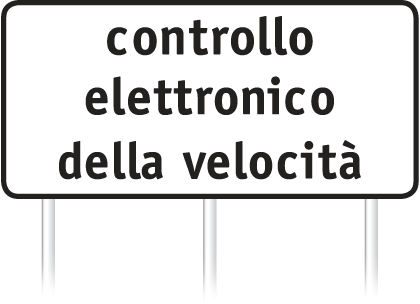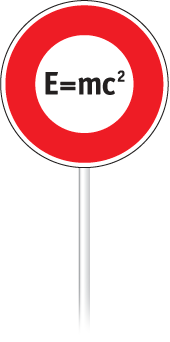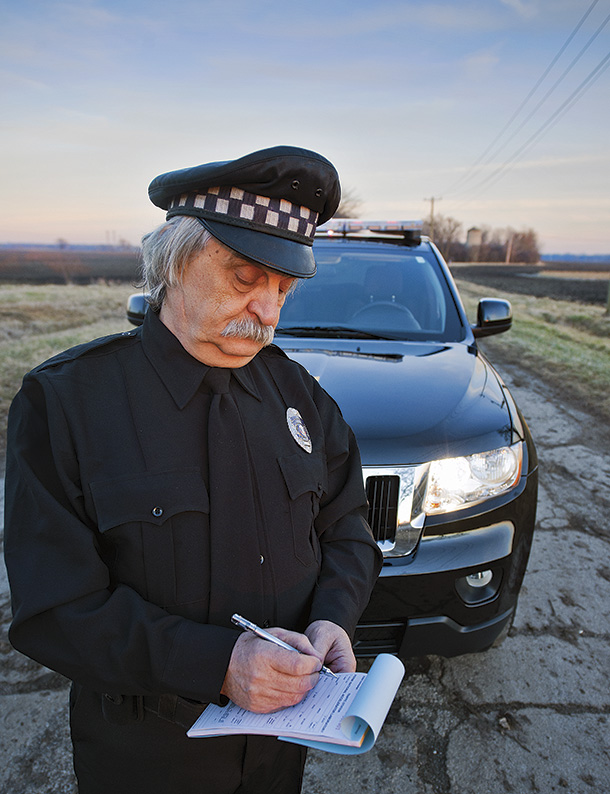
Illustrations: Sandbox Studio
Do you know why I pulled you over?
Exceeding the speed of light has consequences, evenespecially?for neutrinos.
By Judith Jackson
On September 23, 2011, a press release from CERN, the European Organization for Nuclear Research, announced a seminar to be held that very afternoon. Members of the OPERA neutrino experiment would describe their observation of what appeared to be a new property of neutrinos.
Observing and describing new particle properties is what particle physicists do. Every year they publish hundreds of scientific papers, each shedding some new light, however faint, on the properties of the elementary particles and forces of the world around us. Little by little, bit by bitor so the orthodoxy goesover the years these observations construct the extraordinary edifice of our understanding of the fundamental physics of the universe.
Some of these hundreds of papers attract interest within the particle physics community. A few cause a stir at physics conferences. A tiny number come to the notice of the science-minded media. Hardly any get their own press conferences. The OPERA result was different.
After months of checking and cross-checking their measurements, their instruments, their assumptions, their math and anything else they could think of, the OPERA collaborators appeared to have observed a remarkable property of the neutrinos beaming from CERN, in Geneva, to the OPERA detector in the Gran Sasso National Laboratory in central Italy, 730 kilometers away.
The neutrinos appeared to be traveling faster than light.
How fast was I going?
Specifically, the neutrinos from CERN arrived at Gran Sasso 60 billionths of a second sooner than they should have. They crossed the finish line in Italy 20 meters ahead of light.
What? We may not know much about physics, but there's one thing we're sure of, right? Nothing can exceed the speed of light in a vacuum. As the T-shirt says: "186,000 miles per second. It's not just a good idea, it's the law."
And yet those neutrinos, some 15,000 of them, appeared to have done it. It looked as if they'd been caught speeding. That called for a press conference.
In the press release and at the CERN seminar, the OPERA collaborators presented their astonishing finding with the utmost circumspection. They hadn't set out to catch neutrino speeders; they'd been looking for oscillation from one neutrino type to another. They were as shocked as anyone when they clocked neutrinos at light-defying speeds. They assumed they must be wrong. But after months of scrutinizing their results and coming up with the same answer, they decided the time had come to ask the broader physics world to take a look. They especially invited other neutrino experiments, with different teams and different instruments, to see if their neutrinos also outpaced light.
James Gillies, CERN's chief of communication, had learned of the result at a meeting some 10 days earlier.
"It was immediately obvious to me that this story would be huge," Gillies said. "I think the OPERA people knew that too. However, I think they felt a little overwhelmed by the response."
And well they might have, because before you could say "faster-than-light-neutrinos," all hell broke loose.
Printed version
Related content

If neutrinos really did break the speed limit, if E = mc² turned out to be wrong, the implications for physicsand physicistswould be unimaginable.
"Faster than light? I'll eat my shorts."
All hell broke loose in the physics community because, if neutrinos really did travel faster than light, most of modern physics would go out the window. Einstein's 1915 theory of general relativity, the bedrock of 21st-century physics, has profound implications for everything from the workings of your GPS to the big bang to the size of the universe. Built into the theory of general relativity is Einstein's 1905 theory of special relativity, which established the speed of light as the ultimate universal speed limit. If neutrinos really did break the speed limit, if E = mc² turned out to be wrong, the implications for physicsand physicistswould be unimaginable.
"My first reaction was shock and disbelief," Stanford physicist Stan Wojcicki, a long-time leader of Fermilab's MINOS neutrino experiment, told a radio interviewer. In 2007, MINOS itself had reported a possible sighting of neutrinos exceeding the speed limit, but the result was not statistically significant, and most physicists had dismissed it.
Furthermore, there was sound experimental evidence to put neutrinos squarely among the ranks of the law abiding. Observers had reported extremely precise measurements of the speed of both light and neutrinos arriving on Earth from an exploding star known as Supernova 1987A. Given the enormous tracts of the universe they traversed, if neutrinos were traveling at the speeds OPERA recorded, they should have arrived on Earth a year sooner than light. In fact, the neutrinos from the supernova showed up exactly when observers expected, right on time.
Still, despite their skepticismone physicist volunteered to eat his boxer shorts in public if the result held upand their cold sweat about taking physics back to square one, scientists overwhelmingly expressed respect for OPERA's work and for the scientific process.
Notwithstanding his incredulity, Wojcicki said, "I congratulate my [OPERA] colleagues on their meticulous work. This could turn out to be the most important experiment of the century."
Yale neutrino physicist Bonnie Fleming agreed.
"Amid all the skepticism about the OPERA result," she told a group of students a few days after the CERN announcement, "let's remember that neutrinos have surprised us before."
For their part, theorists wasted no time wading in. Maybe, some said, neutrinos just have a different speed limit from other particles, as if the authorities set one limit for Ferraris and another for everything else on the road. Maybe neutrinos were born faster than light and just never looked back. Maybe they're tachyons .
Experimenters and theorists alike agreed on the need for more data and on the value of a scientific process that rejects no result just because it's improbable or inconvenient. The long process of independent checking and "What if?" theorizing began.

Heard the one about the neutrino?
Meanwhile, far beyond the world of physics theory and experiment, the story took off in popular culture.
The webcast of a garden-variety CERN seminar attracts an average of a couple of hundred viewers. When the proceedings got under way on the afternoon of September 23, some 120,000 people tuned in. There aren't that many particle physicists in existence, even allowing for parallel universes. Clearly, plenty of regular people were also listening.
More than 6000 neutrino news stories appeared on September 23rd and 24th alone, with thousands more in following days. Still more stories came in a mid-November second bounce when the collaboration issued a follow-up release explaining that they'd eliminated one potential source of error.
Discover magazine chose faster-than-light neutrinos as the science news story of the year, even though, the editors acknowledged, it might turn out not to be true. From the pages of dozens of publications and websites, Einstein stuck out his tongue at readers, in the famous photograph.
Job applications to CERN climbed by 50 percent on the day of the press conference. Who wouldn't want to work where they make neutrinos that break the speed limit?
At laboratories and physics departments around the world, the phones lit up with pleas from the media for interviews with any physicist who could spell "neutrino." Gillies, a physicist who can spell neutrino in at least six languages, was in high demand by radio and TV.
Headline writers loved the story. "Speed of Light Broken!" "Was Einstein Wrong?" "There Was a Neutrino Named Bright." "Particles Faster Than the Speed of Light? Not So Fast, Some Say."
In the blogosphere, neutrino jokes proliferated:
- And the bartender says, "Sorry, we don't serve faster-than-light neutrinos in here." So this neutrino walks into a bar.
- After neutrino announcement, Moody's downgrades Einstein's theory of general relativity to AA+.
- Neutrino. Who's there? Knock knock.
Even scientists got into the spirit. Italian physicist Sergio Bertolucci, CERN's research director, pointed out that the result could not be true because it breaks a fundamental law of nature: nothing in Italy ever arrives on time.
Something shaking in the firmament?
What is it about faster-than-light neutrinos that made them such an instant sensation in the popular media? How could Gillies so accurately predict that the story would be "huge"?
"Okay, here is my take," says University of Chicago astrophysicist Michael Turner. "Just saying Einstein was wrong gets people's attention, but when how he is wrongspeed limitis easy to understand, the situation is combustible. Add to that the fact that many people are pissed off at the idea of a speed limit and some even believe that the speed of light is just like the speed of sound, a barrier to break, and you have a great story."
Michio Kaku, a theorist at City College of New York, agrees.
"Einstein is the cop on the block," he told an interviewer. "The speed of light is the ultimate speed limit in the universe. At least it was until last week, when all hell broke loose with this press conference."
New York Times science writer Dennis Overbye has a similar view.
"The speed of light is one thing people probably think they know about physics," he says. "Judging by the coverage I saw, a lot of the attraction was the 'Was Einstein Wrong?' angle, which of course is a red herring. So people know that if this turns out to be right, there is something shaking in the firmament."
Other commentators cited the element of time reversalthose jokes!and, perhaps optimistically, a fascination with physics.
Science writer Geoff Brumfiel says it's a law of journalism: "When the speed of light is broken, there will be a story. The speed of light or a black hole." He also believes that "fundamentally, people do take an interest in physics."
The neutrino story had all the elements to produce a global sensation: Einstein, the speed of light, breaking the speed of light, Einstein mistaken, and time travel. The only thing missing was a cataclysmic black hole, although some stories made an attempt to work it in. The story couldn't miss.
When experimenters finally discover the long-sought Higgs boson, object of decades-long searches and endless speculation, will the discovery produce the same worldwide cultural combustion as faster-than-light neutrinos? The Higgs lacks Einstein's imprimatur and as far as we know it moves slower than light. Still, perhaps the Higgs will break new ground and engender excitement that eclipses even the neutrino furor. We'll have to wait and see.
After all, as one recent blog comment noted, "Someone breaks the speed limit in Italy and that's news?"








